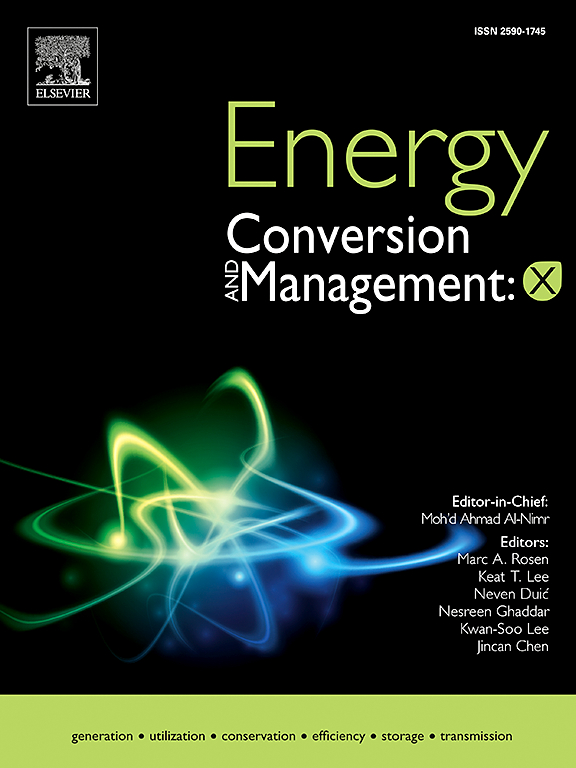Development and verification of a real-time energy management system for a dual-energy electric bus using particle swarm optimization
IF 7.6
Q1 ENERGY & FUELS
引用次数: 0
Abstract
For electric vehicles (EVs), traditional single-battery systems struggle to balance cost, lifespan, and performance under varying load demands and driving cycles. Integrating dual-energy storage systems has thus become an attractive approach to leverage the complementary advantages of each technology. In this study, the main focus is to coordinate power distribution between two different battery types, lead-acid battery and lithium battery. Firstly, a control-oriented third-order EV dynamics was constructed in advance for performance evaluation. For the baseline control, a rule-based control (RBC) with three modes considering demanded power and State-of-Charges (SOCs) of dual energy sources was developed. This study next proposed an advanced energy management system (EMS) adopting the equivalent consumption minimization strategy (ECMS) as the reference of 100 % optimization. Four for-loop layers (demanded power, dual SOCs and power ratio) with a cost function which was the combined power of dual sources influenced by weighting factors of SOCs were constructed. For the Particle Swarm Optimization (PSO) algorithm, the optimal torque distribution ratio was evaluated considering group size. Furthermore, to verify the EMS, a hardware-in-the-loop (HIL) testing framework was constructed to validate the practical feasibility of the proposed strategies under realistic driving conditions. The results demonstrate that, compared to RBC, the proposed ECMS and PSO achieved notable improvements in energy efficiency during the New European Driving Cycle (NEDC), with maximum improvement of 6.62 % and 6.56 %, separately, in pure simulation. For HIL experiments, 10.48 % and 10.41 % improvements were achieved. These findings highlight the practical potential of intelligent optimization algorithms for dual-energy storage systems employed in next-generation electric buses.
基于粒子群算法的双能电动客车实时能量管理系统的开发与验证
对于电动汽车(ev)来说,传统的单电池系统在不同负载需求和行驶周期下努力平衡成本、寿命和性能。因此,集成双能量存储系统已成为利用每种技术互补优势的一种有吸引力的方法。在本研究中,主要关注的是协调铅酸电池和锂电池两种不同类型电池之间的功率分配。首先,构建了面向控制的三阶电动汽车动力学模型,并对其进行了性能评价。对于基线控制,提出了一种基于规则的三种模式控制(RBC),考虑了双能源的需求功率和充电状态(soc)。接下来,本研究提出了一种先进的能源管理系统(EMS),采用等效消耗最小化策略(ECMS)作为100%优化的参考。构建了四个for-loop层(需求功率、双soc和功率比),其代价函数是受soc权重因子影响的双源组合功率。在粒子群优化算法中,考虑群体大小,评估最优扭矩分配比。此外,为了验证EMS,构建了硬件在环(HIL)测试框架,以验证所提出策略在现实驾驶条件下的实际可行性。结果表明,与RBC相比,所提出的ECMS和PSO在新欧洲驾驶循环(NEDC)中取得了显著的能源效率提高,在纯模拟中分别提高了6.62%和6.56%。在HIL实验中,分别提高了10.48%和10.41%。这些发现突出了下一代电动客车双能量存储系统智能优化算法的实际潜力。
本文章由计算机程序翻译,如有差异,请以英文原文为准。
求助全文
约1分钟内获得全文
求助全文
来源期刊

Energy Conversion and Management-X
Multiple-
CiteScore
8.80
自引率
3.20%
发文量
180
审稿时长
58 days
期刊介绍:
Energy Conversion and Management: X is the open access extension of the reputable journal Energy Conversion and Management, serving as a platform for interdisciplinary research on a wide array of critical energy subjects. The journal is dedicated to publishing original contributions and in-depth technical review articles that present groundbreaking research on topics spanning energy generation, utilization, conversion, storage, transmission, conservation, management, and sustainability.
The scope of Energy Conversion and Management: X encompasses various forms of energy, including mechanical, thermal, nuclear, chemical, electromagnetic, magnetic, and electric energy. It addresses all known energy resources, highlighting both conventional sources like fossil fuels and nuclear power, as well as renewable resources such as solar, biomass, hydro, wind, geothermal, and ocean energy.
 求助内容:
求助内容: 应助结果提醒方式:
应助结果提醒方式:


